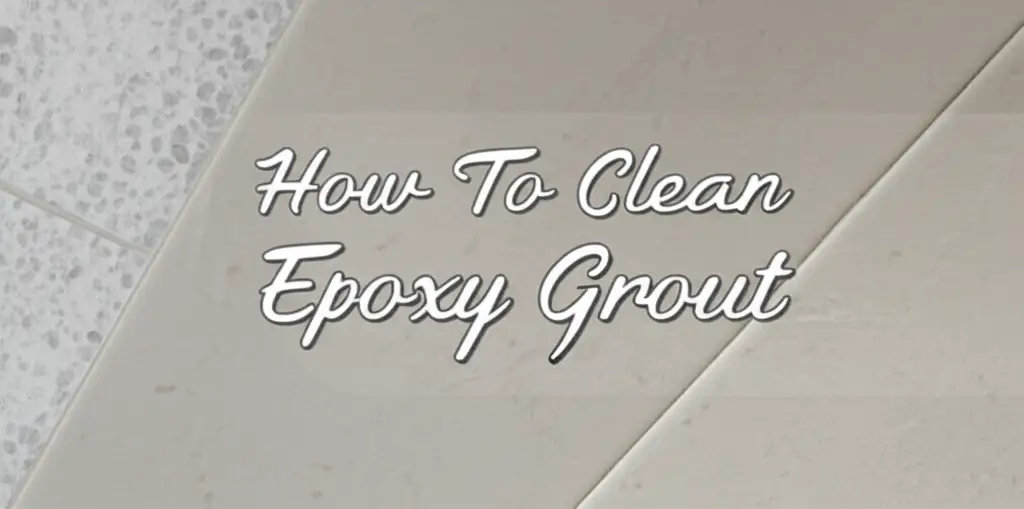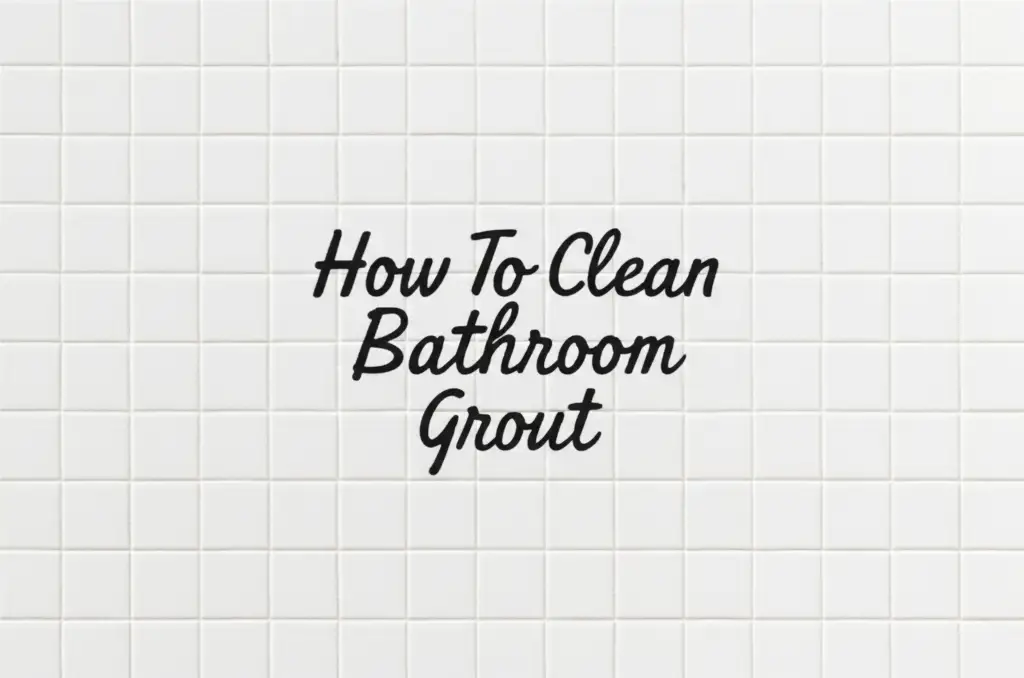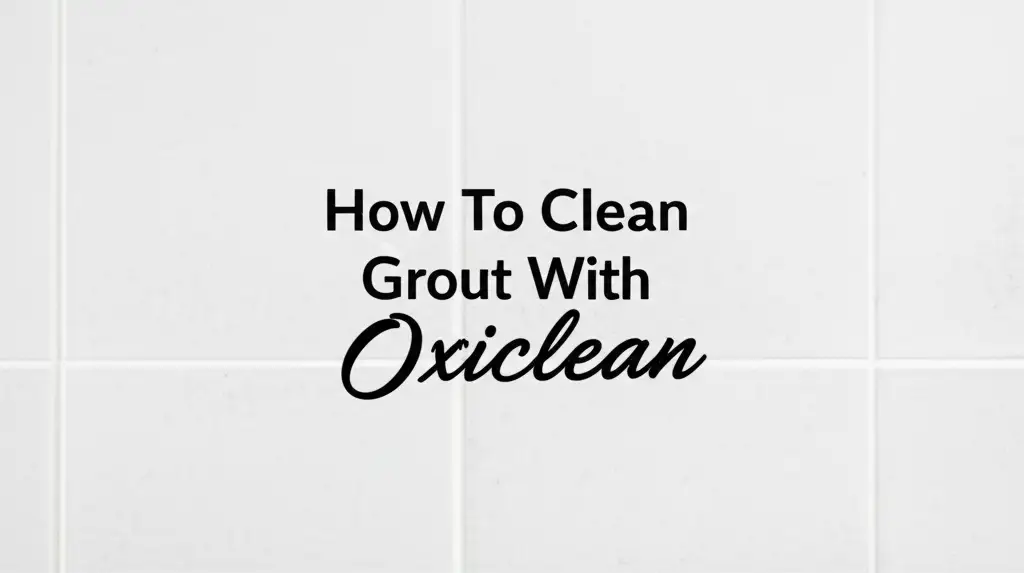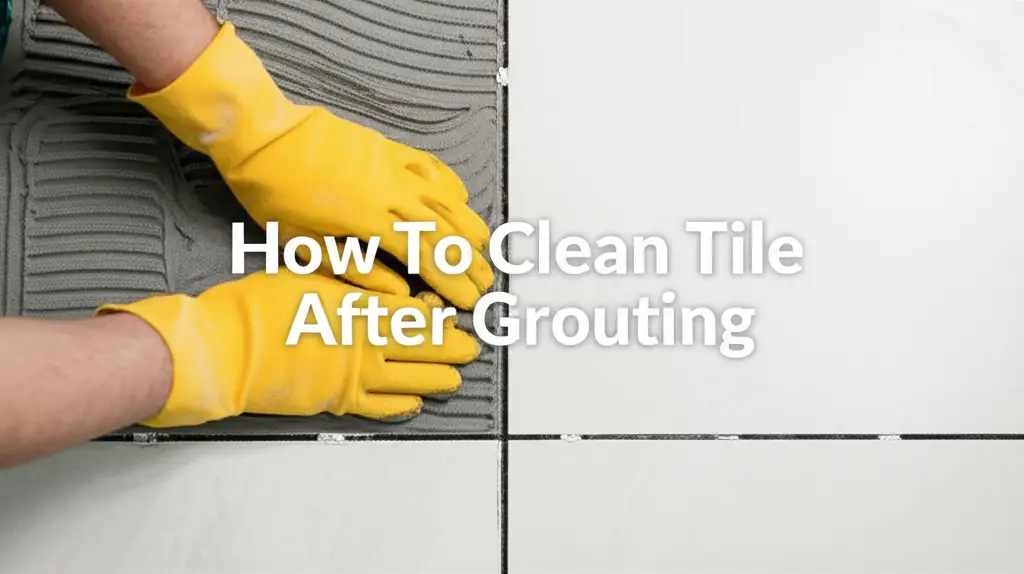· Home Cleaning · 18 min read
How To Clean Epoxy Grout

Clean Epoxy Grout Easily: Your Complete Guide
Epoxy grout is a remarkable material. It offers incredible durability and resistance to stains, mold, and mildew. This makes it a popular choice for high-traffic areas like kitchens and bathrooms. However, even with its superior properties, epoxy grout still requires cleaning. Regular cleaning keeps it looking its best and ensures its longevity. I find that many people think epoxy grout is maintenance-free, but that is simply not true. You must understand the right methods to clean epoxy grout. Incorrect cleaning can damage the surface or leave behind a dull film. This guide provides you with effective strategies to clean your epoxy grout. We will cover routine care, deep cleaning, and how to tackle stubborn issues.
Takeaway:
- Use mild, pH-neutral cleaners for regular cleaning to preserve epoxy grout’s finish.
- Address spills and stains quickly to prevent them from setting.
- Employ specialized epoxy grout cleaners or gentle methods for deep cleaning stubborn grime.
- Avoid abrasive tools and harsh chemicals like bleach or strong acids.
- Regular maintenance keeps your epoxy grout looking pristine and extends its lifespan.
How do you clean epoxy grout?
To clean epoxy grout, use mild, pH-neutral cleaners with a soft-bristled brush or cloth. For stubborn stains, apply a specialized epoxy grout cleaner or a paste of baking soda and water. Always rinse thoroughly with clean water and dry the area to prevent residue buildup.
Understanding Epoxy Grout: Why It’s Unique
Epoxy grout stands apart from traditional cement-based grout. It consists of epoxy resins and a hardener. These components form a durable, non-porous surface. This non-porous nature makes epoxy grout highly resistant to water, stains, and chemicals. Cement grout, in contrast, is porous and easily absorbs spills. This difference means epoxy grout does not typically require sealing. It resists mold and mildew better than cement grout.
Its strength and resilience make epoxy grout an ideal choice for many areas. You often see it in commercial kitchens, showers, and high-traffic floor areas. I always recommend it for places where cleanliness is paramount. Its smooth surface also makes it easier to wipe clean daily. Knowing these properties helps you understand why specific cleaning methods work best. You need to respect its unique composition to clean it correctly.
Gathering Your Tools: Essential Supplies for Cleaning Epoxy Grout
Before you start cleaning epoxy grout, gather the necessary tools and supplies. Having everything ready saves time and makes the job smoother. You do not need a lot of special equipment for most cleaning tasks. The right tools help you clean effectively without damaging the grout. I always make sure I have these items on hand.
Here is a list of what you will need:
- Mild, pH-Neutral Cleaner: Dish soap diluted in water works well for routine cleaning. Many commercial tile and grout cleaners are also pH-neutral. Read the label carefully to ensure it is safe for epoxy.
- Warm Water: This is essential for mixing cleaners and rinsing surfaces.
- Soft-Bristled Brush: A soft brush helps agitate dirt without scratching the epoxy. Old toothbrushes are excellent for small areas or tight corners.
- Microfiber Cloths or Sponges: These are good for applying cleaners and wiping surfaces clean. They absorb liquids well and leave no lint.
- Buckets: You will need one for your cleaning solution and another for rinse water. Using two buckets helps avoid spreading dirty water.
- Rubber Gloves: Protect your hands from cleaners, even mild ones.
- Clean Towels or Mop: For drying the cleaned area completely.
- Specialized Epoxy Grout Cleaner (Optional): For very stubborn stains, a cleaner formulated specifically for epoxy grout may be needed.
Avoid using harsh abrasives like steel wool or scouring pads. Also, stay away from strong acidic or alkaline cleaners unless specifically stated for epoxy. These can dull the finish or cause discoloration over time. Selecting the right tools is the first step to successful epoxy grout cleaning.
Routine Cleaning: Keeping Your Epoxy Grout Spotless Daily
Regular maintenance is key to keeping your epoxy grout looking new. Daily or weekly cleaning prevents dirt and grime from building up. This proactive approach saves you from extensive deep cleaning later. I find that a quick routine keeps my grout looking fresh. This kind of cleaning is simple and does not take much time.
Here are the steps for routine cleaning:
- Clear the Area: Remove any movable objects from the tiled surface. Sweep or vacuum loose dirt and debris. This prevents scratching the grout during cleaning.
- Prepare a Mild Cleaning Solution: Mix a few drops of mild dish soap with warm water in a bucket. You can also use a pH-neutral commercial tile cleaner. For general cleaning, this gentle approach is sufficient.
- Apply the Solution: Dip a microfiber cloth or sponge into the solution. Wring out excess water so it is damp, not soaking wet. Wipe down the epoxy grout lines. For floors, you can use a damp mop.
- Gentle Scrubbing (If Needed): If you see light dirt or scuff marks, use a soft-bristled brush. Gently scrub the grout lines. Do not apply too much pressure. The goal is to lift surface grime.
- Rinse Thoroughly: Fill a second bucket with clean, warm water. Use a clean cloth or mop dampened with this water to wipe down the entire area. Rinse several times to remove all soap residue. Leftover soap can attract more dirt.
- Dry the Surface: Use a clean, dry towel or a dry mop to dry the tiles and grout completely. Drying helps prevent water spots and mildew growth.
- Address Spills Immediately: Epoxy grout resists stains, but quick action is always best. Wipe up spills as soon as they happen. This prevents any potential discoloration, especially from colored liquids like red wine or coffee.
By following these simple steps regularly, you maintain the clean appearance of your epoxy grout. This routine prolongs the life and beauty of your tiled surfaces. For more general advice on keeping your shower clean, you can read our article on how to clean grout in shower.
Deep Cleaning Techniques: Removing Stubborn Stains from Epoxy Grout
Even with regular cleaning, stubborn stains can sometimes appear on epoxy grout. These might be from heavy foot traffic, spilled food, or specific dirt accumulation. Deep cleaning techniques are needed for these tougher challenges. I have found certain methods work better for particular types of stains. This approach requires a bit more effort but yields excellent results.
Here are effective strategies for deep cleaning epoxy grout:
For General Grime and Light Stains:
Baking Soda Paste:
- Mix baking soda with a small amount of water to form a thick paste.
- Apply the paste directly onto the stained epoxy grout lines.
- Let it sit for 10-15 minutes. The baking soda works to gently lift the grime.
- Scrub gently with a soft-bristled brush.
- Rinse the area thoroughly with clean water.
- Dry completely with a clean towel.
Oxygen Bleach Solution (Powdered Oxi-clean):
- Mix oxygen bleach powder with warm water according to package directions.
- Apply the solution to the grout lines.
- Allow it to dwell for 15-30 minutes, but do not let it dry.
- Gently scrub with a soft brush.
- Rinse well with clean water.
- Dry the surface completely. This is a powerful, yet generally safe, method for many stains. Our guide on how to clean grout with OxiClean provides more detail.
For Oil, Grease, or Tougher Stains:
Degreaser or Specialized Epoxy Grout Cleaner:
- Purchase a commercial degreaser or a cleaner specifically designed for epoxy grout. Always check the product label for compatibility.
- Apply the cleaner directly to the stain.
- Follow the manufacturer’s instructions for dwell time. This is important to ensure the product works effectively without harming the grout.
- Use a non-abrasive scrubber or a stiff nylon brush to work the cleaner into the stain.
- Rinse the area several times with clean water.
- Ensure all cleaner residue is gone.
- Dry the area with a clean cloth.
Mineral Spirits (Use with Caution):
- For very stubborn oil-based stains, mineral spirits can be effective.
- Apply a small amount to a clean cloth.
- Dab the stain directly. Do not rub vigorously.
- Work in a well-ventilated area.
- Rinse the area immediately and thoroughly with water and a mild detergent.
- Then rinse again with plain water and dry. Always test in an inconspicuous area first.
Remember to always test any new cleaning solution on an inconspicuous area first. This ensures it does not cause discoloration or damage. Proper ventilation is also important when using stronger cleaners. Dealing with specific stains effectively keeps your epoxy grout looking clean and new. If you’re tackling grime on your floors, our article on how to clean tile grout on floors can provide additional tips.
Dealing with Specific Challenges: Mold and Discoloration in Epoxy Grout
While epoxy grout resists mold and mildew better than traditional grout, it is not entirely immune. Over time, especially in humid environments like showers, surface mold can develop. Discoloration can also occur from certain residues or heavy soiling. Addressing these issues correctly prevents them from worsening. I have seen how quickly mold can spread if not treated promptly.
Here is how to tackle mold and discoloration:
Removing Mold from Epoxy Grout:
Mold on epoxy grout is usually surface growth. It lives on soap scum or dirt accumulated on the grout surface. It does not grow within the epoxy grout itself.
Hydrogen Peroxide Solution:
- Mix equal parts of 3% hydrogen peroxide and water in a spray bottle.
- Spray the solution directly onto the moldy areas.
- Let it sit for 10-15 minutes. Hydrogen peroxide is a powerful disinfectant and mold killer.
- Scrub the grout lines with a soft-bristled brush.
- Rinse the area thoroughly with clean water.
- Dry completely.
- For detailed steps on removing mold, see our guide on how to clean mold from grout.
Borax Solution:
- Mix 1 cup of borax with 1 gallon of warm water.
- Apply the solution to the moldy grout using a sponge or spray bottle.
- Let it sit for at least 15 minutes.
- Scrub with a soft brush.
- Rinse well and dry. Borax is a natural fungicide.
Commercial Mold Remover (Use with Caution):
- If natural solutions are not effective, use a commercial mold cleaner.
- Always choose one safe for epoxy surfaces. Test it in an inconspicuous area first.
- Follow the manufacturer’s instructions precisely.
- Ensure good ventilation when using these products.
Addressing Discoloration and Black Grout:
Discoloration often results from soap scum, hard water, or general dirt buildup. If your grout has turned black, it is likely extreme dirt or mold.
Deep Cleaning with Oxygen Bleach:
- As mentioned in the deep cleaning section, an oxygen bleach solution is excellent for brightening discolored grout.
- Apply the solution, let it dwell, scrub gently, and rinse thoroughly. This can restore much of the original color.
Specialized Epoxy Grout Haze Remover:
- Sometimes, discoloration is actually a grout haze from the original installation that was not fully removed.
- There are specific epoxy grout haze removers available. These products are designed to dissolve stubborn epoxy residues.
- Use these products strictly according to instructions. They are often stronger chemicals.
- For persistent black discoloration, especially in showers, refer to our article on how to clean grout that has turned black.
Prompt action and using the right cleaners are vital for maintaining the appearance of your epoxy grout. Addressing these specific challenges ensures your tiled surfaces remain clean and vibrant.
DIY Cleaner Recipes: Safe Solutions for Epoxy Grout
You do not always need harsh chemicals to clean epoxy grout. Many effective and safe cleaning solutions can be made with common household ingredients. These DIY cleaners are often milder, environmentally friendly, and budget-friendly. I prefer to start with these gentle options whenever possible. They are less likely to cause any damage to your valuable epoxy grout.
Here are some effective DIY cleaner recipes for epoxy grout:
1. Simple Dish Soap Solution (For Routine Cleaning):
- Ingredients:
- 1 teaspoon mild liquid dish soap (like Dawn)
- 1 gallon warm water
- Instructions:
- Mix the dish soap into the warm water until suds form.
- Use a sponge or microfiber cloth dipped in the solution. Wring out excess liquid.
- Wipe down the epoxy grout lines.
- For light grime, gently scrub with a soft brush.
- Rinse the area thoroughly with clean water.
- Dry completely to avoid water spots.
- Best for: Daily or weekly cleaning, light dirt, and general maintenance.
2. Baking Soda Paste (For Light to Medium Stains):
- Ingredients:
- 1/2 cup baking soda
- 2-3 tablespoons warm water (adjust as needed)
- Instructions:
- Combine baking soda and water in a bowl to form a thick, spreadable paste.
- Apply the paste directly onto the stained grout lines.
- Let it sit for 10-15 minutes. The baking soda helps lift and absorb stains.
- Gently scrub the paste with a soft-bristled brush.
- Rinse the area well with clean water until all baking soda residue is gone.
- Dry the grout thoroughly.
- Best for: Food stains, general discoloration, and scuff marks.
3. Hydrogen Peroxide (For Mold and Mildew):
- Ingredients:
- 1 part 3% hydrogen peroxide
- 1 part water
- Instructions:
- Mix hydrogen peroxide and water in a spray bottle.
- Spray directly onto moldy or discolored grout.
- Allow it to sit for 10-15 minutes. Hydrogen peroxide breaks down organic matter.
- Scrub gently with a soft brush.
- Rinse the area thoroughly with clean water.
- Dry completely.
- Best for: Surface mold, mildew, and brightening discolored grout. For more on this, check out our guide on how to clean grout with hydrogen peroxide.
4. White Vinegar (Use with Caution, Test First):
- Note: While epoxy grout is acid-resistant, prolonged exposure to strong acids can dull its finish. Always dilute vinegar and test in an inconspicuous area. Do not use on adjacent natural stone tiles.
- Ingredients:
- 1 part distilled white vinegar
- 1 part water
- Instructions:
- Mix equal parts white vinegar and water in a spray bottle.
- Spray directly onto the grout.
- Let it sit for 5-10 minutes.
- Scrub gently with a soft brush.
- Rinse immediately and very thoroughly with clean water.
- Dry the surface.
- Best for: Light soap scum, hard water spots, and mild dirt. Use this as a last resort among DIY methods if other mild cleaners fail, and only after testing.
These DIY recipes offer effective and safe alternatives for cleaning your epoxy grout. Always start with the mildest solution and progress to stronger options only if necessary. Consistency with these gentle methods helps maintain your grout’s pristine condition.
Maintaining Your Epoxy Grout: Long-Term Care Tips
Proper maintenance extends the life and beauty of your epoxy grout. It keeps your tiled surfaces looking their best for many years. Epoxy grout is tough, but a little care goes a long way. I find that following a few simple practices makes a big difference. This section offers practical advice for long-term care.
Here are essential tips for maintaining your epoxy grout:
Regular Cleaning Schedule:
- Establish a consistent cleaning routine. Wipe down your epoxy grout weekly with a mild, pH-neutral cleaner.
- Daily wipe-downs in high-use areas like shower floors prevent soap scum and grime buildup.
- This stops dirt from setting into the grout lines, making future cleaning easier.
Address Spills Immediately:
- Epoxy grout resists stains, but no material is entirely stain-proof if liquids sit for too long.
- Wipe up spills, especially colored liquids like coffee, wine, or juice, as soon as they happen.
- A quick wipe with a damp cloth prevents potential discoloration.
Avoid Harsh Chemicals and Abrasive Tools:
- Steer clear of strong acids, alkalis, bleach, and abrasive cleaners. These can dull the epoxy finish or, in extreme cases, damage the grout over time.
- Never use steel wool, abrasive scouring pads, or hard wire brushes. These will scratch the surface of the epoxy, making it harder to clean in the future.
- Stick to soft-bristled brushes, sponges, and microfiber cloths.
Ensure Proper Ventilation:
- In areas like bathrooms and showers, good ventilation is crucial.
- Use exhaust fans during and after showers. Open windows to allow air circulation.
- This helps dry out the environment. It reduces the conditions favorable for mold and mildew growth on the grout surface.
Use Doormats and Rugs:
- For epoxy grout on floors, use doormats at entry points.
- Place rugs in high-traffic areas.
- These items trap dirt and debris. This reduces the amount of grime tracked onto your grout. This also minimizes wear and tear.
Periodic Deep Cleaning:
- Even with regular maintenance, deep cleaning is occasionally necessary.
- Depending on usage, plan for a deep clean every few months.
- Follow the deep cleaning methods outlined previously. Target any stubborn stains or buildup.
By integrating these long-term care tips into your cleaning habits, your epoxy grout will retain its pristine appearance and perform excellently for many years. Consistent, gentle care is the best way to protect your investment.
What to Avoid: Harmful Practices for Epoxy Grout
Knowing what to avoid is as important as knowing what to do when cleaning epoxy grout. Using the wrong products or methods can dull the finish, cause discoloration, or even damage the grout. I have seen many people make these mistakes, leading to unnecessary frustration. Protecting your epoxy grout means understanding these pitfalls.
Here are key things to avoid when cleaning your epoxy grout:
Harsh Acids and Alkalis:
- Do not use cleaners with high acidity (like strong vinegar solutions, lemon juice, or rust removers) or high alkalinity (like ammonia-based cleaners or oven cleaners) regularly.
- While epoxy grout is generally acid-resistant, concentrated or prolonged exposure to strong acids can dull its sheen over time.
- These harsh chemicals can also leave a sticky residue that attracts more dirt, creating a cycle of needing more aggressive cleaning.
Bleach (Especially Undiluted):
- Avoid using undiluted bleach. While a very diluted bleach solution can kill mold, bleach can potentially discolor colored epoxy grout.
- It can also leave behind a residue that attracts dirt. For mold, hydrogen peroxide or oxygen bleach are safer, more effective alternatives.
Abrasive Cleaners and Tools:
- Never use abrasive powders, scouring creams, steel wool pads, or stiff wire brushes.
- These materials can scratch the smooth, non-porous surface of the epoxy grout. Scratches create microscopic crevices. Dirt and grime can then embed themselves more easily. This makes future cleaning harder.
- Stick to soft-bristled brushes, sponges, or microfiber cloths.
Oil-Based Cleaners or Waxes:
- Do not use oil-based cleaners, waxes, or sealers on epoxy grout.
- Epoxy grout is non-porous and does not need sealing. These products will only leave a sticky film or residue on the surface.
- This film attracts dirt, leaves footprints, and makes the grout appear dull or greasy.
Steam Cleaners (Use with Caution):
- While some argue steam cleaners are safe, the high heat can soften the epoxy grout if used improperly or too close to the surface for too long.
- Excessive heat can also affect the bond between the grout and the tile. If you use a steam cleaner, keep the nozzle moving and do not dwell on one spot. Test a small area first.
Leaving Residue:
- Always rinse your epoxy grout thoroughly after cleaning.
- Leaving any cleaner residue behind can attract dirt, create streaks, or make the grout look dull.
- Follow every cleaning session with a clear water rinse and then dry the surface completely.
By avoiding these common mistakes, you protect your epoxy grout. This ensures it stays clean, vibrant, and durable for many years. A gentle, consistent approach is always the best strategy.
FAQ Section
Q1: Is epoxy grout hard to clean?
Epoxy grout is generally easier to clean than traditional cement grout. Its non-porous nature means it resists stains and water absorption. Most daily dirt wipes away with a mild cleaner and soft cloth. Stubborn stains might need a bit more effort, but overall, maintenance is simpler compared to porous grout types.
Q2: Can you use bleach on epoxy grout?
It is best to avoid using bleach on epoxy grout, especially undiluted. While diluted bleach might kill mold, it can potentially discolor colored epoxy grout over time. It may also leave a residue that attracts dirt. Safer and more effective alternatives include hydrogen peroxide or oxygen bleach solutions.
Q3: How do you remove black mold from epoxy grout?
Black mold on epoxy grout usually grows on surface grime, not within the grout itself. To remove it, spray a solution of equal parts 3% hydrogen peroxide and water onto the mold. Let it sit for 10-15 minutes, then scrub gently with a soft brush, rinse thoroughly, and dry.
Q4: Does epoxy grout stain easily?
No, epoxy grout does not stain easily. It is highly resistant to stains because of its non-porous, dense composition. This makes it a superior choice for areas prone to spills. However, quick clean-up of spills is still recommended to prevent any potential surface discoloration or residue buildup.
Q5: How often should I clean epoxy grout?
For optimal maintenance, clean epoxy grout in high-traffic or wet areas like showers weekly with a mild, pH-neutral cleaner. For less used areas, bi-weekly or monthly cleaning may suffice. Address any spills immediately. Deep clean every few months or as needed for stubborn grime.
Q6: What is the best cleaner for epoxy grout?
The best cleaner for epoxy grout is a mild, pH-neutral detergent mixed with warm water for routine cleaning. For more stubborn issues, a baking soda paste or a solution of hydrogen peroxide works well. Always avoid harsh acids, strong alkalis, and abrasive cleaners, as they can damage the grout’s finish.
Conclusion
Cleaning epoxy grout is not a difficult task. It requires understanding its unique properties and using the right methods. You now have the knowledge to keep your epoxy grout looking impeccable. Regular, gentle cleaning with mild, pH-neutral solutions is your first line of defense. This proactive approach prevents the accumulation of dirt and grime. I have always found that prevention is easier than cure.
Remember to arm yourself with the proper tools. Use soft brushes and microfiber cloths. Avoid harsh chemicals and abrasive scrubbers at all costs. These can damage the durable finish you rely on. By implementing these simple, effective cleaning techniques, you ensure your epoxy grout remains vibrant and functional for many years. Your epoxy grout is a durable investment. With consistent care, it will continue to enhance the beauty of your home. Start applying these tips today. Enjoy your pristine epoxy grout!
- epoxy grout
- cleaning grout
- tile cleaning
- grout maintenance
- home improvement
- grout cleaner




